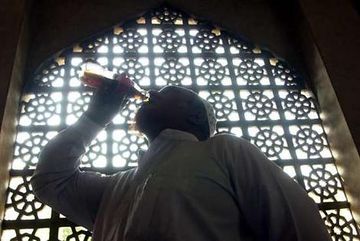From WikiIslam, the online resource on Islam
Jump to navigation
Jump to search
|
|
| Line 184: |
Line 184: |
|
| |
|
|
| |
|
| <option weight="1">{{Pictorial-Islam|1=Setting the Record Straight: The Non-Miracle of Islamic Science|2=[[File:The Miracle of Islamic Science.jpg|180px|link=Setting the Record Straight: The Non-Miracle of Islamic Science]]|3=This is a refutation of Dr K. Ajram's Setting the Record Straight: The Miracle of Islamic Science. The purpose of this analysis is to put the achievements of Golden Age Muslim scientists in the proper perspective; neither denigrating their achievements nor inflating them. All scientific and technological progress is accomplished in progression; Muslim achievements are but links in the chain. Few of the great Muslim scientific achievements stood alone, but were derived by Muslim scientists standing on the shoulders of those who came before them. This analysis also highlights the fatal flaw of the Islamic Golden Age. There were few ‘follow-up’ breakthroughs on the backs of the works of the great Muslim scientists. In effect, the Ummah allowed or encouraged these works to wither on the vine or die stillborn, even before the rise of mysticism at the expense of rational thinking, an event often attributed to al-Ghazzali around the turn of the 12th century. Indeed, it would seem orthodox Islam utterly stifles intellectual reasoning. Therefore, Islam is not the cause of scientific progress during the Golden Age. Many people would say that the Golden Age scientific progress was made in spite of Islam, not because of it. A prime example is the great philosopher-physician Ibn Sina (Avicenna) whose work is constantly referenced by Dr K. Ajram. ([[Setting the Record Straight: The Non-Miracle of Islamic Science|''read more'']])}}</option> | | <option weight="1">{{Pictorial-Islam|1=Setting the Record Straight: The Non-Miracle of Islamic Science|2=[[File:The Miracle of Islamic Science.jpg|150px|link=Setting the Record Straight: The Non-Miracle of Islamic Science]]|3=This is a refutation of Dr K. Ajram's Setting the Record Straight: The Miracle of Islamic Science. The purpose of this analysis is to put the achievements of Golden Age Muslim scientists in the proper perspective; neither denigrating their achievements nor inflating them. |
| | |
| | All scientific and technological progress is accomplished in progression; Muslim achievements are but links in the chain. Few of the great Muslim scientific achievements stood alone, but were derived by Muslim scientists standing on the shoulders of those who came before them. |
| | |
| | This analysis also highlights the fatal flaw of the Islamic Golden Age. There were few ‘follow-up’ breakthroughs on the backs of the works of the great Muslim scientists. In effect, the Ummah allowed or encouraged these works to wither on the vine or die stillborn, even before the rise of mysticism at the expense of rational thinking, an event often attributed to al-Ghazzali around the turn of the 12th century. ([[Setting the Record Straight: The Non-Miracle of Islamic Science|''read more'']])}}</option> |
|
| |
|
|
| |
|
Revision as of 22:19, 31 January 2014
Also see: Template:Pictorial-Islam
Fatwa on Coke and Soft Drinks
|
|

|
|
The Mujlisul Ulama of South Africa has established beyond any doubt that Coca Cola as well as all other soft drinks contain very small quantities of alcohol. In this fact there is no doubt and the manufacturers of these minerals cannot and do not dispute this claim. Attached hereto are papers which testify to the validity of our claim. The concentrates from which soft drinks are produced contain about 20% alcohol by volume. It is from such alcoholic concentrates that Coke and other minerals are made. In the final product, viz. the soft drink, small quantities of alcohol remain. It is, therefore, unreasonable and utterly baseless to deny the alcohol-content of Coke and other soft drinks. These minerals are made from only alcoholic concentrates and the final product contains minute quantities of the alcohol. (read more)
|
|
|
